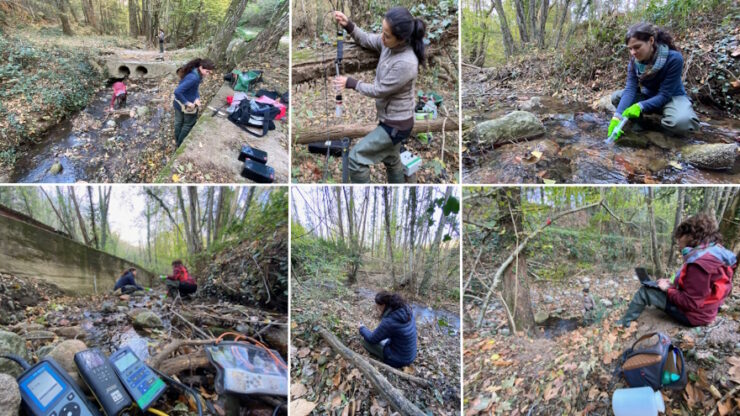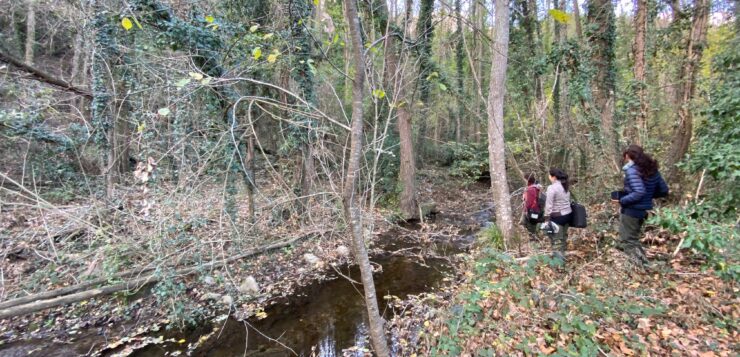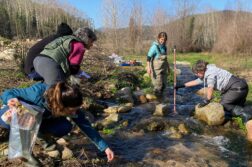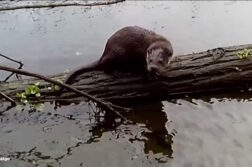Until recently, it was thought that the thickness of CO2 they released was due to what they drained from the terrain. Scientists from CEAB-CSIC have revealed that, in Mediterranean streams, this does not explain even half of the emissions of this gas. They have shown that more than 50% of the emissions result from processes that occur within the river itself. To study this further, they are developing the research project Evasiona.
In a scientific article published in Limnology and Oceanography, a team led by researchers from the Advanced Studies Center of Blanes (CEAB-CSIC) in collaboration with University of Florida (USA), provided evidence that more than half of the carbon dioxide released into the atmosphere by two different types of headwater streams did not come from the terrestrial system but rather from metabolic processes within the river, such as animal respiration or the decomposition of organic matter by bacteria. This publication differed from previous studies. Most articles were based on research conducted in wetter regions and assigned minimal importance to river metabolism in the carbon balance, showing that the bulk of emissions resulted from lateral inputs of groundwater, that is, from the CO2 drained from the soil.
Susana Bernal, the lead author of the study, explains that «it was acknowledged that the river breathes, but it was believed that these internal processes had very little importance in the CO2 balance. It was seen as more “passive,” like a kind of “chimney” that simply releases what it receives. With our research, we found that its respiration, at least in the type of rivers we studied, Mediterranean rivers, weighs much more».
The research was conducted in two tributaries of a mediterranean river (La Tordera, in Catalunya, Spain). One, at the head of Montseny mountains, always carries water. The other, in Montnegre mountains, runs dry in some periods of the year. Continuous measurements of carbon dioxide and oxygen in these two tributaries with different characteristics—also regarding the type of riparian forest, lateral water inputs, or sunlight reaching them—led to the same conclusion: river respiration accounted for more than 50% of the total CO2 evasion balance in the atmosphere. Specifically, in the Montseny stream, it accounted for 51%. And in the Montnegre stream, it was 57%.
The researcher details that in the case of the first tributary, groundwater inputs are important, and the river’s metabolism is very active: «microorganisms “work” a lot, decomposing organic substances rapidly, which explains that 50% of CO2 emissions come from respiration that occurs in the river. As for the second case, not much groundwater enters, and, in fact, it is completely dry for long periods. The origin of the emitted CO2 is more “mysterious.” For now, we attribute the high emission of carbon dioxide to anaerobic processes, which occur when there is no oxygen in the water, and bacteria must respire other elements to obtain energy from organic matter such as the leaf litter that falls in the riverbed».

To study everything in-depth, the team has recently launched a new research project called Evasiona, which builds on the groundbreaking research. It includes continuous monitoring of the two tributaries for two hydrological years (from September to August).
Carolina Játiva and Anna Lupon, researchers on this project, explain, «we have about 30 sensors that continuously measure different parameters such as dissolved oxygen in the water, flow, carbon dioxide, pH, or the light reaching the river. Additionally, every three weeks, we come to the field and, besides maintaining the sensors and downloading the data, we manually take measurements of the river, the surrounding wells, the atmosphere… and make calculations. All of this should allow us to learn more about the carbon cycle and how the river functions.»
The research’s objective is to gain a better understanding of the role that river respiration plays in carbon dioxide emissions to comprehend how these ecosystems influence greenhouse gas emissions on a global scale. Studies like this allow us to better understand the functioning of rivers and guide key decisions to preserve them in good health, thus reducing the CO2 they emit.





